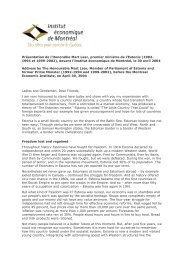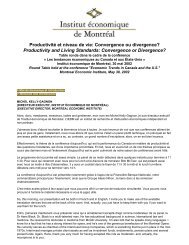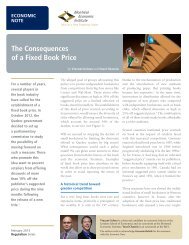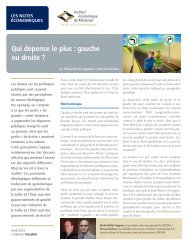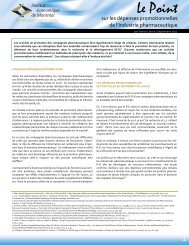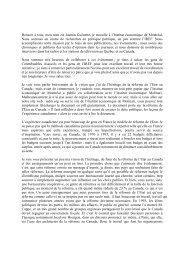Union certification: Developing a level playing field ... - LabourWatch
Union certification: Developing a level playing field ... - LabourWatch
Union certification: Developing a level playing field ... - LabourWatch
Create successful ePaper yourself
Turn your PDF publications into a flip-book with our unique Google optimized e-Paper software.
<strong>Union</strong> <strong>certification</strong>: <strong>Developing</strong> a <strong>level</strong> <strong>playing</strong> <strong>field</strong> for labour relations in Quebec5. The relativeeconomic performanceof Quebec, the rest ofCanada and the UnitedStates: growth, jobcreation and privateinvestmentQuebec’s distinct position with regard tolabour relations legislation makes it useful tocompare the province’s economic performancewith that of its direct North Americancompetitors over the last 26 years. 1 Although thisexercise cannot establish a direct causality, giventhe many factors involved, it does help us picturethe ground Quebec could gain by adopting moreflexible labour laws that would favour strongerjob creation and increased productivity inparticular.GDP growth rateFrom 1981 to 2007, the average annualgrowth rate of Quebec’s gross domestic product(GDP) 2 was 2.2%, compared to 2.9% in the restof Canada. This amounts to a 77.0% overallincrease in Quebec’s real GDP and a 112.4%increase in the rest of Canada. Quebec’s real GDPrepresented 23.2% of Canada’s GDP in the early1980s but only 20.2% in 2007.More recently, from 2002 to 2007, theaverage annual variation in real GDP was 1.8% inQuebec, compared to 2.8% in the rest of Canada.Quebec’s real GDP thus rose by 9.4% over thisperiod, whereas real GDP in the rest of Canadawent up by 14.8%. At this pace, Quebec’s GDPwould climb 56.6% in the 25 years from 2007 to2032, while the GDP rise in the rest of Canadawould be 99.3%. Quebec’s economic weightwould then account for only 16.6% of theCanadian total.1. This section draws upon Marcel Boyer, “La performance économiquedu Québec: constats et défis (IV)”, CIRANO, November 2008,http://www.cirano.qc.ca/pdf/publication/2008s-29.pdf.2. GDP is a commonly accepted aggregate measure of a country’s or aregion’s economic activity. It measures the value of all goods andservices produced.Figure 5.1Comparison of GDP growth:Quebec, rest of Canada, United States (1981-2007)240220QuebecRest of CanadaUnited States200Index (1981=100)180160140120100801981 1983 1985 1987 1989 1991 1993 1995 1997 1999 2001 2003 2005 2007Sources: Statistics Canada, CANSIM Table 384-0002 (expenditure-based GDP); Bureau of Economic Analysis, May 2007.Montreal Economic Institute27



